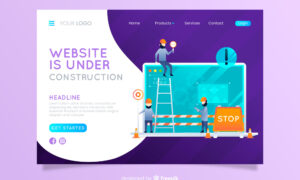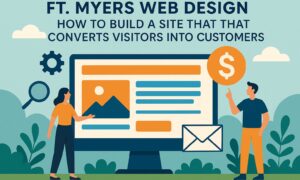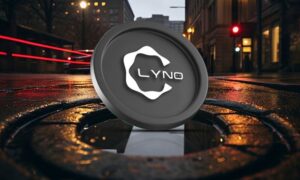In today’s digital age, having a strong online presence is no longer optional for trucking companies—it’s essential. Whether you’re an independent owner-operator or run a large fleet, a well-designed website can set you apart from the competition, attract more clients, and streamline operations. In this guide, we’ll explore the key elements of effective trucking web design and how it can help you drive more business online.
Why a Website Matters for Trucking Companies
The trucking industry is competitive, and many potential clients and partners turn to the internet to find reliable services. A website serves as a 24/7 digital storefront, allowing prospects to learn about your company, request quotes, and even track shipments. Without a solid web presence, you’re missing out on valuable business opportunities.
Here are some key benefits of a well-designed trucking website:
- Credibility & Professionalism: A professional website instills trust and makes your company look established and reliable.
- Lead Generation: Online forms and contact pages make it easy for potential clients to reach out.
- Operational Efficiency: Integration with booking, dispatch, and tracking software can streamline business operations.
- SEO Visibility: A search-optimized site helps your business appear in relevant Google searches.
- Brand Awareness: A website enhances your brand identity, reinforcing your business values and mission.
- Customer Engagement: Features like blogs, newsletters, and social media integration keep your audience engaged.
Key Features of an Effective Trucking Website
To ensure your website delivers results, it must be designed with both aesthetics and functionality in mind. Here are some must-have features:
- Mobile-Friendly & Responsive Design
Most users today browse the internet from their smartphones. A mobile-responsive design ensures your site looks and functions perfectly on all devices. Google also ranks mobile-friendly sites higher in search results.
- Clear Navigation & User Experience (UX)
Visitors should be able to find what they need quickly. A well-structured menu with clear categories—such as “About Us,” “Services,” “Get a Quote,” and “Contact”—improves user experience. A clutter-free, intuitive design prevents frustration and increases conversions.
- Strong Call-to-Action (CTA)
Encourage visitors to take action, whether it’s requesting a quote, calling for more information, or booking a shipment. Prominent CTA buttons, such as “Get a Free Quote,” help increase conversions. Using contrasting colors and strategic placement makes CTAs stand out.
- Service Pages & Industry-Specific Content
Highlight your specialties, whether it’s long-haul trucking, freight brokerage, logistics, or refrigerated transport. Detailed service pages boost SEO and help clients understand your offerings. Including case studies and examples of successful deliveries further strengthens credibility.
- Load Tracking & Customer Portal
If possible, integrate tracking features that allow clients to check shipment status in real time. A customer portal can also improve client experience and retention by providing order histories, invoices, and direct communication with support.
- SEO Optimization for Trucking Keywords
A website is useless if no one can find it. SEO (Search Engine Optimization) helps you rank higher in search engines. Focus on keywords like “trucking services near me,” “freight transportation company,” and “logistics solutions.” Regularly updating your blog with industry insights and news also improves SEO rankings.
- Testimonials & Trust Signals
Adding customer reviews, testimonials, and industry certifications builds credibility and reassures potential clients that they’re making the right choice. Featuring partner logos and trust badges can further enhance trustworthiness.
- Fast Load Speed & Secure Hosting
Slow websites drive visitors away. Optimize images, minimize code bloat, and choose a reliable hosting provider to ensure fast performance. Security is also crucial—SSL certificates and secure payment options protect customer data and build trust.
- Social Media Integration
Having social media links on your website allows visitors to stay updated with your latest news and promotions. A strong social presence helps in brand building and customer engagement.
- Blog & Industry News Section
A blog section featuring industry news, safety tips, and regulatory updates positions your company as an authority. It also improves SEO and attracts organic traffic.
Web Design Trends for the Trucking Industry
To stay ahead of the competition, it’s essential to incorporate modern web design trends. Here are some of the latest trends in trucking web design:
- Minimalist Design: Clean, simple layouts with bold typography improve readability.
- Dark Mode Options: More websites now offer dark mode for better user experience.
- AI Chatbots: Automated chatbots help answer common questions and assist visitors 24/7.
- Interactive Maps: Show service areas or real-time route tracking.
- Video Backgrounds: High-quality videos showcasing fleet operations can enhance engagement.
- Voice Search Optimization: Optimizing for voice search makes it easier for truckers and logistics managers to find your services hands-free.
Common Mistakes to Avoid in Trucking Web Design
While designing a website, trucking businesses often make the following mistakes:
- Ignoring Mobile Optimization: A non-responsive site loses potential customers.
- Lack of Clear Contact Information: Your phone number, email, and address should be easy to find.
- Too Much Technical Jargon: Keep content simple and easy to understand for non-industry visitors.
- Overloading with Stock Photos: Use real images of your fleet and team for authenticity.
- No Clear Call-to-Action: Always guide users toward the next step.
- Poor Website Maintenance: Outdated information and broken links can make your business look unreliable.
How to Get Started with Your Trucking Website
If you’re ready to upgrade or build your trucking website, follow these steps:
- Choose a Domain Name: Pick something easy to remember and relevant to your business.
- Select a Web Hosting Provider: Opt for a reliable hosting company with fast speeds and security.
- Plan Your Website Structure: Outline the key pages and navigation menu.
- Hire a Web Design Expert: A professional trucking web design company can help you create a high-performing site.
- Optimize for SEO: Conduct keyword research and implement best practices for ranking higher.
- Test and Launch: Ensure everything works perfectly before going live.
- Monitor & Update: Regularly update content, fix bugs, and analyze visitor behavior to improve performance.
Final Thoughts
A well-crafted trucking website is a game-changer for your business. It not only establishes credibility but also helps you attract more clients and streamline operations. By incorporating the right features, avoiding common mistakes, and staying up-to-date with trends, you can build a website that drives success.
If you’re looking for a professional trucking web design company, reach out today. Our team specializes in creating powerful, conversion-focused websites tailored to the trucking industry. Let’s build a website that keeps your business moving forward!



































